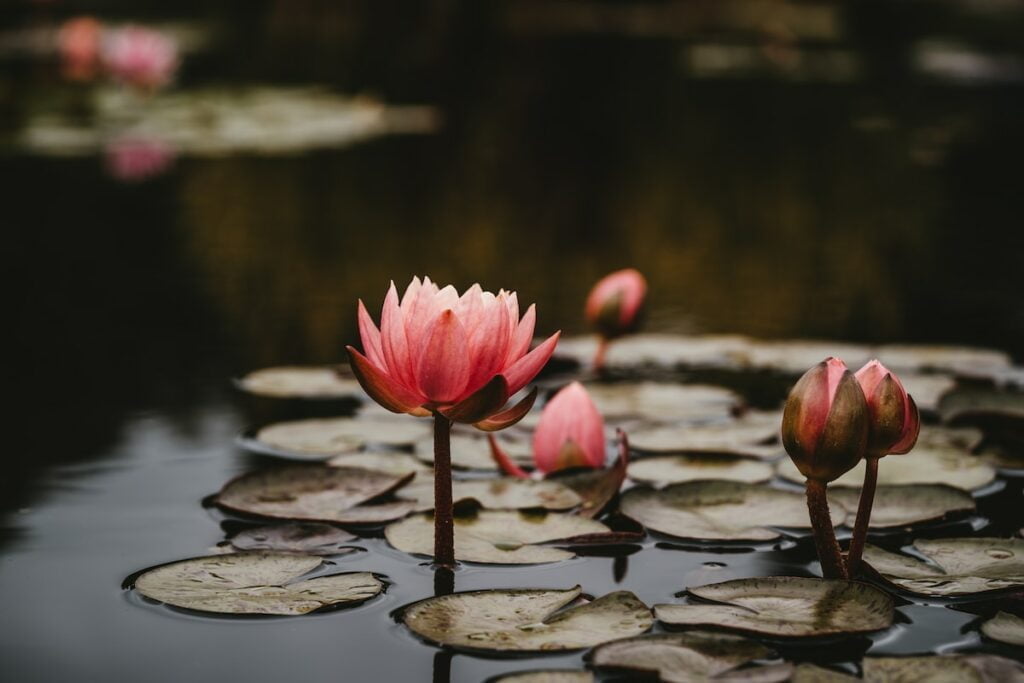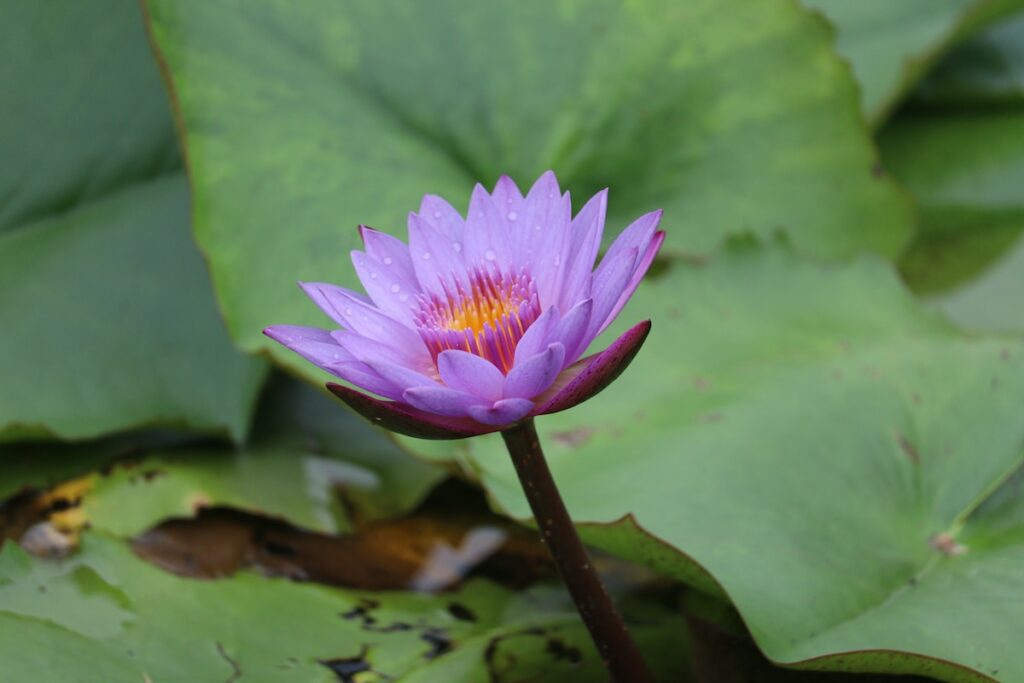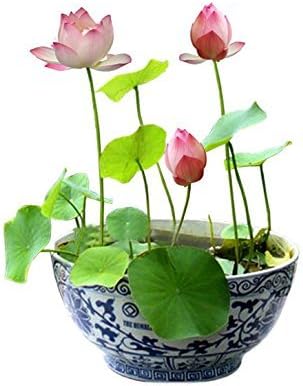Lotus flowers, with their exquisite beauty and resilience, have been adding beauty to our life and garden, for centuries. Lotus’ ability to bloom from the mud’s depth and shine radiantly in daylight represents resilience, purity, and spiritual awakening. In Western societies, where a sense of disconnection and high-paced stress is often experienced, growing lotus at home can serve as a powerful symbol of inner peace and spiritual growth.
This article provides a simple guide to growing your lotus and explores the journey of this ancient spiritual symbol from philosophy to the the contemporary Western life all the way to your garden.


Lotus dancing with the Sun: a reflection of life
In Buddhism, the lotus is associated with purity, spiritual awakening, and faithfulness. The flower rises from muddy waters, which represent attachment and carnal desires. As the flower blooms untouched by the impurity, it represents the act of rising above all desires and attachments – the path towards spiritual enlightenment.
Hindu tradition also reveres the lotus. It is associated with divine beauty, fertility, prosperity, spirituality, and eternity. Many Hindu gods and goddesses are depicted sitting on lotus thrones, indicating divine origin.
Ancient Egyptians associated the lotus with rebirth and the Sun. Every night the lotus closes, and in the morning, it blooms again, mirroring the sun’s cycle and therefore symbolizing rebirth and regeneration.
The relationship between the lotus and the sun is one of profound interdependence and symbiosis. Mirroring the sun’s daily journey, the lotus flower opens its petals at dawn, revealing its full beauty. As the sun sets, the lotus recedes, withdrawing its petals and retreating into the calmness of the pond.
This harmonious dance mirrors the essence of our human lives. Just as the lotus mirrors the sun, we often mirror the qualities and behaviours of those around us. This process of mirroring, though often subconscious, shapes our interactions, relationships, and ultimately our identity.
Mirroring is a natural human behaviour where one person subconsciously imitates the gesture, speech pattern, or attitude of another. This behavioural synchrony often unfolds in social situations, especially in the company of close friends or family, and usually goes unnoticed by both parties involved.
Scientific research reveals that mirroring is a significant factor in social bonding. It aids in empathy, fosters understanding, and strengthens relationships. When we mirror someone, we subtly signal that we understand and share their feelings, that we are ‘in sync’ with them.

Lotus inspiring your lifestyle and enriching your garden
In many ways, our lives mirror the journey of the lotus. Just as the lotus grows through mud and water to reveal its radiant bloom, we navigate through trials and tragedies to reach our inner beauty. The lotus flower’s journey symbolizes resilience and the transformative power of self-discipline, offering a beautiful metaphor for human potential and self-awareness.
However, the lotus does not merely passively endure its growth process. It actively seeks light, stretching towards the sun, its source of life and energy. This is another powerful aspect of the lotus’s symbolism: the proactive pursuit of growth, wisdom, and enlightenment.
We can choose to mirror the attributes we admire in others – kindness, empathy, resilience, and more. By doing so, we absorb these qualities and integrate them into our behavior, gradually evolving and blooming, just like the lotus.
Thus, the lotus’s journey, mirrored in our lives, serves as a reminder of our potential for transformation and growth. In the clamour and pace of contemporary Western society, the silent wisdom of the lotus offers a beacon of tranquillity, resilience, and continual self-improvement. It reminds us that, like the lotus seeking the sun, we can actively choose the qualities we wish to mirror, guiding our journey towards inner peace and self-realization.
The Lotus in Western Life
In a Western context, the lotus embodies an individual’s journey towards self-realization and inner peace. In a society often governed by immediacy, the slow and thoughtful growth process of the lotus serves as a reminder of patience, persistence, and the beauty of unfolding life’s journey.
In the face of challenges, the symbolism of the lotus encourages individuals to rise above struggles, much like the lotus rises above the mud to bloom. The flower’s journey from murky waters to stunning bloom can inspire those facing adversity, symbolizing the possibility of growth and transformation through difficult circumstances.
The tranquil presence of a lotus at home could serve as a reminder of the potential for inner peace amidst life’s constant busyness. The practice of nurturing a living thing, observing its growth, and being patient. The process of growing a lotus in your garden serves as a compelling reminder of patience, resilience, and the beauty of our own personal growth journey. Much like the lotus, we can strive to seek light in our lives, reaching towards knowledge, truth, and the warmth of positive relationships.
Growing your Lotus: from seed to flower
Firstly, it’s important to understand the steps of growing a lotus flower. Here’s a step-by-step guide:
- Choosing the Right Lotus Seed: Lotus seeds are resilient and can remain viable for many years. When choosing your seed, look for ones that are dark brown and spherical, not damaged or cracked.
- Preparing the Seed: Use a metal file or sandpaper to scuff one side of the seed, until the creamy interior is visible. This will encourage germination.
- Germination: Place the seed in warm water, replacing it daily. After a week or so, a sprout should appear.
- Planting the Seedling: When the sprout is about an inch long, it’s ready to plant. Choose a no-hole container and use clay-based aquatic soil. Plant the seedling, leaving the growth tip exposed.
- Watering and Sunlight: Add water above the soil level and make sure your lotus gets at least six hours of sunlight daily.
- Caring for the Lotus: As leaves appear, add more water. Once the plant is mature, fertilize it every few weeks.
Patience is key in this process. Cultivating a lotus takes time, symbolizing the journey of self-growth and understanding – it’s not an instant gratification exercise.


Moving Lotus to its final home in your garden
Once your lotus plant has sprouted a few leaves and established a healthy tuber, it’s time to relocate it to its permanent home. This phase is vital, as it lays the groundwork for your lotus’s eventual maturity and blooming.
First, choose a vessel that is wide and shallow, allowing the plant to spread out. Then, layer 3-5 inches of a soil mixture, preferably a heavy loam soil, at the bottom of the container. Carefully plant your lotus tubers into this soil. The tubers should be shallowly buried, with the growing tips pointing upwards and the majority of the tuber horizontally situated.
After the tubers are safely nestled in the soil, fill the container with warm water until it barely tops the young leaves. It’s critical to ensure that the leaves are not submerged completely; they need to breathe and access light for photosynthesis.
As your lotus continues its growth journey, the leaves will gradually rise above the water level. During this phase, you can slowly start adding more water to the container. Be mindful to maintain the water level, ensuring it doesn’t drop excessively due to evaporation. The aim is to eventually have the water level reach the top of the pot.
Lotus requires patience, but what a blooming reward
With this, your primary responsibilities as a lotus caretaker are fulfilled. Now, it’s a matter of patience and routine observation. Once your lotus starts producing aerial leaves, that is, leaves that rise above the water, it’s a clear indication that your plant is maturing.
But the joy of growing a lotus is not confined to the eventual blossoming of the flower. The journey is, in itself, an engaging experience. It’s fascinating to watch the lotus plant change and grow, transforming from a tiny sprout to a plant with aerial leaves.
However, do not expect the blooms in the first year; lotus plants usually flower in their second year. When they do finally bloom, they create a stunning display that lasts for about three days. The flowers usually open in the early morning and close in the late afternoon.
Growing a lotus at home creates a small oasis, a corner of tranquillity and beauty, right in your backyard or porch. More than just a hobby, it’s a way of connecting with nature and drawing upon the wisdom that the lotus symbolizes – patience, purity, and spiritual awakening. Enjoy your lotus journey!
Do you want to share your story and inspire our readers ? Know that every story is paving the way for a brighter, happier future.






